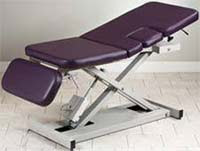Diagnosing Your Needs for Diagnostic Tables
Wednesday, October 05, 2011
What is the best type of diagnostic table for a general practice that sees a range of patients from children through to the elderly?
Depending on the type of tables you are considering from C-Arm tables through to ultrasound and imaging tables there are several excellent choices for general practices. Since you want a table that is easily accessible for both younger patients as well as elderly people with possibly mobility issues, c onsider a power table. While these are more expensive they also save stress on the patients and prevent the need for assisted transfers by staff members. Power tables can have a variety of additional features including being on casters to allow easy positioning and movement. Most C-Arm tables will be designed with casters however they may not have the hi low power option, so you do have to decide which is functionally more important in your particular practice.
onsider a power table. While these are more expensive they also save stress on the patients and prevent the need for assisted transfers by staff members. Power tables can have a variety of additional features including being on casters to allow easy positioning and movement. Most C-Arm tables will be designed with casters however they may not have the hi low power option, so you do have to decide which is functionally more important in your particular practice.Are there different types of diagnostic tables that are designed specifically for work with bariatric patients and what features do they have?
Diagnostic tables for bariatric patients tend to have reinforced steel angles and reinforcement on the stress points of the table. They can also have additional braces and support in the central column or the leg area under the table. This reinforcement is very discreet and virtually undetectable, giving all the equipment in your exam rooms the same appearance. This is ideal in creating a coordinated office that still can safely and easily accommodate patients of all weights and sizes.
I want to create a less institutional look to my diagnostic area, what options do I have in diagnostic tables that would look less like standard medical equipment?
With more and more offices becoming environmentally friendly and using more green types of equipment and furnishings when possible the need for natural products in diagnostic tables has come to the surface. In addition the movement towards more patient friendly equipment has also created a demand for natural woods and less institutional looking furnishings and equipment. The result is that tables are now available with an eco-friendly wood construction protected with wood designed laminate. This combination of natural appearance with strength, durability and long lasting surface protection is very popular in all types of clinical settings. It is also possible to choose upholstery colors in natural shades such as greens, browns, burgundies and blues that are very soothing and "natural" in appearance.
Labels: Diagnostic Table, Exam Table, Treatment Table









0 Comments:
Post a Comment
<< Home